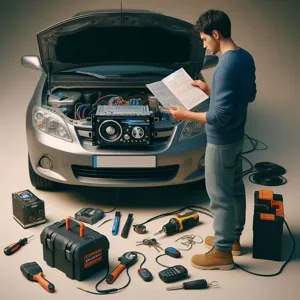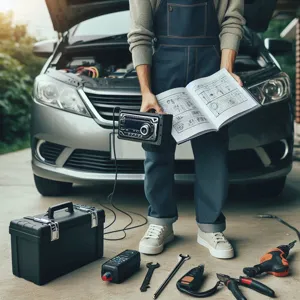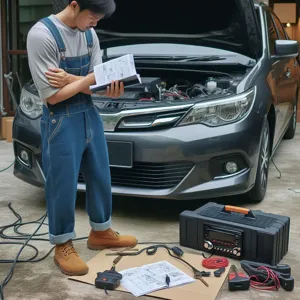Imagine cruising down the open road with your favorite tunes enveloping you in a rich, immersive sound experience—every note crystal clear, every bassline resonant.
For many car enthusiasts, a high-quality audio system is not just a luxury; it’s an essential part of the driving experience. However, with a dizzying array of options available on the market, choosing the perfect car audio system can feel overwhelming. From understanding different audio components to knowing how to match them to your vehicle’s specifications, selecting the right system requires careful consideration. In this ultimate guide, we’ll break down everything you need to know to transform your ride into a mobile concert hall. Whether you’re a casual listener or a dedicated audiophile, we’ll help you navigate through the myriad of choices, ensuring that you hit the road with an audio setup that perfectly complements your style and enhances every journey.
1. Understanding Your Audio Needs

When embarking on the journey to choose the perfect car audio system, the first step is to thoroughly understand your audio needs. This foundational knowledge will guide you in selecting components that not only fit your vehicle but also enhance your listening experience.
Begin by evaluating how you typically use your audio system. Are you a casual listener who enjoys podcasts and the occasional music playlist, or do you crave high-fidelity sound that brings your favorite tracks to life? If you often find yourself driving long distances or stuck in traffic, investing in a system that offers immersive sound quality could greatly enhance your daily commute.
Next, consider your musical preferences. Different genres can greatly influence the type of audio system that suits you best. For instance, if you have a penchant for bass-heavy music like hip-hop or electronic, you might prioritize subwoofers and amplifiers that can handle low frequencies without distortion. On the other hand, if you favor classical or acoustic genres, clarity and balance might take precedence, leading you to seek out high-quality speakers and tweeters that replicate those nuanced sounds.
Don’t forget to factor in the size and layout of your vehicle. A compact car may require a different approach than a spacious SUV or truck. Measure the available space for speakers and subwoofers to ensure that your chosen components will fit seamlessly into your car. Additionally, think about whether you prefer a simple setup or a more complex, multi-component system that includes components like equalizers or additional amplifiers for a more personalized sound experience.
Lastly, reflect on your budget. Car audio systems can range from affordable options to high-end setups that can cost thousands. Knowing your price range will help narrow your options and ensure you’re investing wisely without sacrificing quality. By taking the time to understand your audio needs, you’ll be better equipped to choose a system that not only meets your expectations but elevates every drive into a sonic adventure.
2. Types of Car Audio Systems
When it comes to enhancing your driving experience, the type of car audio system you choose plays a pivotal role. Understanding the various types available will help you find the perfect fit for your vehicle and your listening preferences.
**1. Factory Audio Systems**
Most vehicles come equipped with a factory audio system, which is designed to meet basic sound quality and functionality needs. While these systems can be satisfactory for casual listeners, they often lack the depth, clarity, and power that audiophiles crave. upgrading from a factory system can dramatically improve your sound experience, making it worth considering if you’re serious about your music.
**2. Aftermarket Audio Systems**
Aftermarket systems offer a world of possibilities, allowing you to customize your audio experience to suit your unique tastes. These systems can range from simple upgrades, such as replacing the head unit or speakers, to comprehensive setups that include amplifiers, subwoofers, and advanced digital signal processors (DSPs). Popular brands like Pioneer, Kenwood, and Alpine provide a plethora of options tailored for various sound preferences, from booming bass to crystal-clear highs.
**3. Component Systems vs. Coaxial Systems**
Within the aftermarket category, you’ll find two main types of speaker systems: component and coaxial. Component systems feature separate speakers for high frequencies (tweeters) and low frequencies (woofers), providing superior sound quality and clarity. They allow for more precise placement within the vehicle, which enhances the overall listening experience. On the other hand, coaxial systems, also known as full-range speakers, combine both tweeters and woofers into one unit, making them an excellent option for those seeking a straightforward upgrade without the complexity of installation.
**4. Subwoofers**
No car audio system is complete without considering the impact of subwoofers. These specialized speakers are designed to reproduce low-frequency sounds, adding depth and richness to your music. If you enjoy genres that emphasize bass—like hip-hop, electronic, or rock—a dedicated subwoofer can transform your listening experience. They come in various sizes and configurations, allowing you to choose a model that fits your vehicle’s space and your desired sound profile.
**5. Integrated Systems**
For those who prefer simplicity and modern technology, integrated systems offer a sleek solution. These all-in-one units often combine a digital media receiver with built-in amplifiers and speakers, providing an easy installation process and a clean aesthetic. Many integrated systems also come equipped with features like Bluetooth connectivity, smartphone integration, and touchscreen displays, catering to tech-savvy drivers looking for convenience and functionality.
By familiarizing yourself with these different types of car audio systems, you can make an informed decision that aligns with your preferences, lifestyle, and budget. Whether you’re a casual listener or a sound enthusiast, there’s a perfect audio setup waiting for you to elevate your driving experience.
3. Key Components of a Car Audio System

When it comes to elevating your driving experience, understanding the key components of a car audio system is essential. Each element plays a crucial role in delivering crisp sound and a rich auditory landscape that can transform every journey into a concert-like experience. Here’s a breakdown of the fundamental components you should consider:
1. **Head Unit**: Often referred to as the heart of the car audio system, the head unit controls the audio output and serves as the interface for your music. Modern head units come equipped with various features, including Bluetooth connectivity for hands-free calling and streaming, USB ports for charging devices and playing music, and even touchscreen displays with navigation capabilities. When choosing a head unit, prioritize compatibility with your smartphone and ease of use to ensure seamless operation while on the road.
2. **Speakers**: The quality of your speakers will significantly influence the sound clarity and overall listening experience. There are several types of speakers to choose from, including coaxial (full-range) speakers that combine multiple driver types into one unit for a compact solution, and component speakers that separate the tweeters and woofers for superior sound reproduction. Consider the size of your vehicle and the kind of sound you prefer—whether it’s powerful bass or crystal-clear highs—to determine the best speaker setup for your ride.
3. **Amplifiers**: While the head unit and speakers play vital roles, amplifiers boost the audio signal to produce a more robust sound. They can enhance the performance of your speakers, especially when you’re pushing high volumes or using high-quality audio files. Depending on your audio preferences, you may want a dedicated amplifier for your subwoofer to achieve that deep, resonant bass that makes your music come alive.
4. **Subwoofers**: For audiophiles who crave that deep bass thump, adding a subwoofer is a game-changer. These specialized speakers are designed to reproduce low frequencies, delivering a powerful foundation to your music that standard speakers often struggle to achieve. Whether you opt for a compact subwoofer that fits under a seat or a larger, more powerful unit that takes up trunk space, a good subwoofer can significantly enhance your listening experience.
5. **Wiring and Accessories**: Don’t overlook the importance of quality wiring and accessories. The right cables can prevent signal loss and distortion, ensuring that the audio quality remains pristine. This includes speaker wire, power wire, and RCA cables, as well as any necessary adapters for seamless integration with your vehicle’s existing systems.
By understanding these key components of a car audio system, you can make informed decisions that cater to your specific listening preferences and enhance your overall driving experience. Whether you’re a casual listener or a dedicated audiophile, selecting the right combination of these elements will ensure that your car audio setup delivers the sound quality you desire, turning every drive into an enjoyable auditory adventure.
4. Setting a Budget: What to Consider
Setting a budget for your car audio system is a pivotal step that can significantly influence your overall satisfaction and the quality of your installation. Before diving headfirst into the sea of options, it’s essential to take a moment to reflect on several key factors that will help you allocate your funds wisely.
First and foremost, assess your audio needs and preferences. Are you a casual listener who enjoys background music on commutes, or are you an audiophile seeking crystal-clear sound quality and booming bass? Your audio ambitions will dictate how much you should set aside. A basic system with a head unit and factory speakers might suffice for everyday listening, while enthusiasts may want to invest more heavily in high-end components, amplifiers, and subwoofers.
Next, consider the cost of installation. If you’re planning to do the installation yourself, you might save a significant amount, but keep in mind the time and expertise required. On the other hand, if you’re opting for professional installation, factor in those costs as they can vary widely depending on the complexity of the system and the rates of the installer.
Don’t forget to include accessories in your budget, such as wiring kits, sound deadening materials, and even custom enclosures for subwoofers. These elements can enhance the performance of your audio system and ensure a seamless installation, but they can also add to your overall expenses.
Lastly, it’s wise to leave a small cushion in your budget for unexpected expenses or upgrades. The world of car audio is ever-evolving, and you might find enticing new components or accessories that could elevate your experience even further.
By carefully considering these factors and setting a realistic budget, you’ll be well on your way to choosing a car audio system that not only fits your vehicle but also aligns with your listening desires, ensuring an enjoyable driving experience for years to come.
5. Choosing the Right Head Unit

Choosing the right head unit is a crucial step in enhancing your car audio experience, as it serves as the command center for your sound system. This is where the magic happens—where you control the music, adjust the volume, and even manage your phone calls. With an overwhelming array of options on the market, selecting the perfect head unit can feel daunting. However, understanding a few key features can simplify your decision.
First and foremost, consider compatibility with your vehicle. Ensure that the head unit fits your car’s dashboard and integrates seamlessly with its existing features. Many modern head units are designed to fit a standard double-DIN or single-DIN slot, but it’s essential to double-check specifications to avoid installation headaches.
Next, think about the connectivity options. In today’s digital age, Bluetooth capability is a must-have, allowing you to stream music and make hands-free calls with ease. Additionally, look for USB ports for charging your devices and auxiliary inputs for connecting older gadgets or non-Bluetooth devices. For those who love streaming music services, check if the head unit supports Android Auto or Apple CarPlay, which can unlock even more functionality and convenience.
Sound quality is another critical factor. Look for features like a built-in equalizer, which allows you to fine-tune your audio settings according to your preferences. Some head units even come equipped with high-quality DACs (Digital-to-Analog Converters) that improve sound clarity and depth, making every note more vibrant.
Don’t forget about the display options. A clear, bright screen with an intuitive interface can significantly enhance your user experience. Touchscreen displays are popular for their ease of use, enabling you to navigate through menus and playlists with just a swipe.
Finally, consider additional features that might enhance your driving experience, such as built-in navigation, customizable backgrounds, or even compatibility with backup cameras. Investing in the right head unit not only elevates your audio experience but also adds an extra layer of functionality to your vehicle, turning every drive into a pleasure-filled journey.
By taking the time to evaluate these factors, you can choose a head unit that perfectly matches your needs and preferences, setting the stage for an exceptional car audio experience that keeps you entertained on the road.
6. Selecting Speakers: Types and Sizes
When it comes to car audio systems, selecting the right speakers is crucial for achieving the sound quality and listening experience you desire. With a myriad of types and sizes available, making an informed choice will not only enhance your music enjoyment but also ensure that your investment pays off in the long run.
**Types of Speakers**
Car speakers generally fall into three main categories: coaxial (full-range), component, and subwoofers.
1. **Coaxial Speakers**: These are the most common type found in stock audio systems. They combine multiple speaker elements—such as woofers and tweeters—into a single unit, making installation simpler and usually more affordable. Coaxial speakers are designed to provide a balanced sound across various frequencies, making them a versatile option for most listeners.
2. **Component Speakers**: For audiophiles seeking superior sound quality, component speakers are the way to go. These systems separate the different elements (woofers, tweeters, and sometimes mid-range speakers), allowing for better sound staging and clarity. While they may require more effort to install and can be pricier, the enhanced audio experience is often worth it for discerning listeners.
3. **Subwoofers**: If you crave deep bass and booming sound, incorporating a subwoofer into your audio setup is essential. Subwoofers are designed specifically to handle low-frequency sounds, providing that thumping bass that can elevate your listening experience. They come in various sizes, typically ranging from 8 to 15 inches, and can be powered by an external amplifier for maximum performance.
**Sizes of Speakers**
Speaker size matters, as it often correlates with sound output and depth. Most factory-installed speakers are around 6.5 inches, which can deliver decent sound but may not satisfy those who desire richer audio. If you’re looking to upgrade, consider the size of your vehicle and the space available for new speakers. Larger speakers can produce deeper bass and louder sound, but they may require modifications to fit properly.
When selecting speakers, it’s also vital to consider the power handling (measured in watts) and sensitivity (measured in decibels). Higher sensitivity ratings mean more volume with less power, while adequate power handling ensures your speakers won’t distort or get damaged when pushed to their limits.
In summary, choosing the right speakers involves understanding the types that best fit your audio preferences and ensuring the sizes align with your vehicle’s specifications. By taking the time to evaluate your options, you’ll be well on your way to creating a car audio system that delivers exceptional sound, making every drive an enjoyable experience.
7. The Importance of Amplifiers

When it comes to upgrading your car audio system, one component that often gets overlooked is the amplifier. However, amplifiers play a crucial role in enhancing your listening experience, making them an essential aspect of any high-quality sound system. These powerful devices serve as the backbone of your audio setup, providing the necessary power to drive your speakers and deliver crisp, clear sound at any volume.
Think of an amplifier as the heart of your car audio system. It takes the low-level audio signals from your head unit and boosts them to a level that can adequately power your speakers. This not only improves the overall sound quality but also allows your speakers to perform at their best, minimizing distortion and maximizing clarity. Whether you’re jamming to your favorite tunes on a long road trip or enjoying a podcast during your daily commute, a good amplifier can make a world of difference in how you experience sound in your vehicle.
When selecting an amplifier, consider the types and number of speakers in your car. You’ll want to choose an amplifier that matches the power requirements of your speakers for optimal performance. Pay attention to the wattage – the higher the wattage, the more power your amplifier can deliver. Also, look for features such as built-in crossovers or adjustable gain controls that can help you fine-tune your audio experience.
Moreover, the installation of an amplifier can help you achieve a more immersive audio environment. By placing the amplifier in a strategic location, you can minimize signal loss and ensure that the sound reaches every corner of your vehicle. Whether you prefer thumping bass that shakes the car or crystal-clear highs that make vocals shine, an amplifier is key to achieving that perfect sound balance.
In summary, investing in a quality amplifier is an indispensable step in creating a car audio system that not only meets but exceeds your expectations. So, as you embark on your journey to elevate your car’s sound system, don’t underestimate the importance of amplifiers—they are the powerhouses that will bring your musical dreams to life, transforming your daily drives into an audio adventure!
8. Subwoofers: Enhancing Bass Performance
When it comes to car audio systems, the heart-pounding thrill of a deep bass line can make all the difference in your listening experience. This is where subwoofers come into play, transforming your vehicle into a concert hall on wheels. A subwoofer is specifically designed to reproduce low-frequency sounds, allowing you to feel the music as much as you hear it. If you’re serious about enhancing your car’s audio experience, investing in a quality subwoofer is essential.
Choosing the right subwoofer involves several factors, including size, power, and enclosure type. Subwoofers range from compact 8-inch models, which can fit neatly into smaller spaces, to powerful 15-inch beasts that require more room but deliver earth-shattering bass. Consider how much space you have in your vehicle; if you’re tight on room, a smaller sub may be your best bet, while larger vehicles can accommodate more robust options.
Power handling is another crucial aspect to consider. Measured in watts, this indicates how much power the subwoofer can handle without distortion or damage. Look for a subwoofer that matches the output of your amplifier to ensure optimal performance. Generally, a higher wattage means deeper, louder bass, but be mindful of pairing it with an adequate amplifier to avoid underpowering or overpowering the sub.
Additionally, the type of enclosure you choose—sealed, ported, or bandpass—will significantly impact the sound quality and performance of your subwoofer. Sealed enclosures provide accurate and tight bass, while ported enclosures can enhance volume and efficiency, allowing for a more booming sound. Bandpass enclosures, on the other hand, are designed to amplify certain frequencies, making them ideal for those who prioritize deep bass impact in their music.
Ultimately, enhancing bass performance with subwoofers is about finding the right balance between size, power, and enclosure type that fits both your vehicle and your personal audio preferences. Once installed, you’ll be amazed at how a quality subwoofer can elevate your car audio system from ordinary to extraordinary, bringing your favorite tracks to life in a whole new way. So, buckle up and get ready to feel the rhythm like never before!
9. Wiring and Installation Considerations
When it comes to upgrading your car audio system, wiring and installation considerations play a pivotal role in ensuring optimal performance and longevity of your setup. While it’s tempting to dive straight into choosing the flashiest speakers or the most powerful amplifier, neglecting the wiring can lead to subpar sound quality and even damage your equipment.
First and foremost, consider the quality of the wiring itself. Investing in high-quality, oxygen-free copper (OFC) wiring can significantly enhance signal clarity and reduce resistance, allowing your audio system to perform at its best. Look for gauge sizes that match your system’s power requirements—generally, lower gauge numbers indicate thicker wires, which are better suited for handling higher currents. For instance, a 4-gauge wire is recommended for amplifiers that draw significant power, whereas a 16-gauge wire might suffice for smaller components.
Next, think about the installation process. While some tech-savvy car enthusiasts may enjoy the DIY approach, others may prefer to enlist the help of professionals. If you opt for a DIY installation, ensure you have the right tools at your disposal, such as wire strippers, crimping tools, and a quality soldering iron. Familiarize yourself with the layout of your vehicle and the specific requirements of your audio components to avoid any surprises during the installation.
Additionally, pay close attention to the routing of your wires. Keep power wires separated from signal wires to minimize interference, which can lead to unwanted noise and distortion in your audio output. Secure all wiring with zip ties or clips to prevent them from moving around while you drive, which can cause wear and tear over time.
Finally, don’t overlook the importance of proper grounding. A solid ground connection is crucial for preventing hum and noise in your audio system. Choose a clean, bare metal surface in your vehicle for grounding your amplifier, and ensure the connection is secure to avoid any disruptions in performance.
By carefully considering your wiring and installation choices, you’ll set the stage for a car audio system that not only sounds incredible but also stands the test of time, allowing you to enjoy your favorite tunes on the road for years to come.
10. Soundproofing Your Vehicle for Optimal Sound
When it comes to achieving the best audio experience in your car, soundproofing is a game-changer. While upgrading your speakers and head unit can significantly enhance sound quality, without addressing the acoustics of your vehicle, you may not be able to enjoy the full potential of your investment. Soundproofing your vehicle is essential for minimizing outside noise, reducing vibrations, and creating a more immersive listening environment.
Start by evaluating the areas of your car that are most susceptible to noise. The doors, floor, trunk, and even the roof are prime candidates for soundproofing. High-quality sound deadening materials, such as butyl rubber mats or foam insulation, can be strategically applied to these areas. These materials work by absorbing sound waves, preventing them from entering or resonating within your vehicle.
Installing soundproofing materials is often a straightforward DIY project. For instance, when treating your doors, you can remove the inner panel, apply the sound deadening mat to the outer skin, and then reassemble everything. This simple step alone can drastically reduce road noise and enhance the clarity of your audio system. Similarly, applying soundproofing mats to the floor and trunk will help keep the bass from escaping, allowing for a richer low-frequency experience.
Additionally, consider sealing any gaps or openings where sound can leak in. This includes ensuring that windows and doors close tightly and adding weatherstripping if necessary. Don’t forget about the windshield; a high-quality acoustic windshield can significantly reduce external noise as well.
By investing time and effort into soundproofing your vehicle, you create an acoustic sanctuary that allows your car audio system to shine. Your music will sound clearer, your bass will feel deeper, and your overall listening experience will be transformed. In the end, the right soundproofing not only protects your investment in car audio but also elevates your daily drive into a concert hall on wheels.
11. Brands to Consider: Top Car Audio Manufacturers
When it comes to enhancing your vehicle’s sound system, choosing the right brand can make all the difference. With a plethora of options available on the market, it’s essential to narrow down your choices to those manufacturers that have earned a reputation for quality, performance, and reliability. Here are some of the top car audio manufacturers you should consider when upgrading your ride’s audio experience.
**1. Pioneer**
Pioneer has long been a leader in the car audio industry, known for its innovative technology and high-quality sound. Their products range from head units to speakers and subwoofers, offering a blend of style and performance. With features like Bluetooth connectivity, touchscreen displays, and customizable settings, Pioneer’s systems cater to audiophiles and casual listeners alike.
**2. Kenwood**
Kenwood is another trusted name that consistently delivers impressive sound quality and user-friendly interfaces. Their car audio systems often come equipped with advanced technology such as voice recognition, smartphone integration, and high-resolution audio playback. Kenwood’s speakers and amplifiers are designed to provide deep, rich sound, making them a favorite among music lovers.
**3. JL Audio**
If you’re looking for powerful bass and exceptional clarity, JL Audio is a brand that stands out. Specializing in subwoofers and amplifiers, JL Audio products are engineered to deliver robust performance without compromising quality. Their commitment to innovation has made them a go-to choice for those seeking to create a premium audio experience in their vehicles.
**4. Alpine**
Alpine is synonymous with high-performance audio. Renowned for their exceptional sound quality and innovative features, Alpine offers a diverse range of products, including head units, speakers, and subwoofers. Their systems often feature advanced tuning options and high-tech integration with smartphones, ensuring that your music sounds great no matter where the road takes you.
**5. Rockford Fosgate**
For those who crave a powerful audio experience, Rockford Fosgate delivers with robust amplifiers and subwoofers designed to shake your car’s foundation. Known for their durability and top-notch performance, Rockford Fosgate products are perfect for creating an immersive sound environment that brings your favorite tunes to life.
**6. Sony**
Sony is a household name in consumer electronics, and their car audio systems are no exception. With a range of head units featuring advanced connectivity options, as well as speakers that produce crisp and clear sound, Sony combines style and functionality. Their systems often incorporate innovative technology, such as smartphone integration and voice controls, making it easy to enjoy your favorite music on the go.
When choosing the perfect car audio system, consider not only the brand’s reputation but also the specific features and performance characteristics that align with your listening preferences. By selecting from these top manufacturers, you’re well on your way to transforming your vehicle into a mobile concert hall, ensuring every drive is an auditory delight.
12. Listening Tests: What to Look For
When it comes to selecting the ideal car audio system, listening tests are an essential step that shouldn’t be overlooked. This is where the rubber meets the road, or rather, where the sound meets your ears. The right audio system should resonate with your personal preferences and enhance your driving experience, so it’s crucial to evaluate its performance before making a purchase.
Begin by finding a demo vehicle or a sound room that allows you to hear the audio system in action. Bring along your favorite music—tracks that you are intimately familiar with. This helps you gauge how well the system reproduces the nuances of sound you love. Pay attention to the clarity of the vocals, the depth of the bass, and the crispness of the highs. You want a system that delivers a balanced sound, where no single frequency overwhelms the others.
Next, listen for distortion. Crank up the volume and observe how the audio holds up. A quality system should maintain clarity even at high volumes, without becoming muddy or harsh. If you notice any distortion or loss of detail, it may be a sign that the system isn’t up to par.
Additionally, assess the soundstage—the way the audio seems to fill the space around you. A good system will create an immersive sound experience, making it feel as if the music is surrounding you rather than just emanating from the speakers.
Don’t forget about the dynamic range. Pay attention to how well the system handles both quiet and loud passages of music. You should be able to hear the subtle details in soft sections while still feeling the punch of powerful crescendos.
Lastly, consider the ease of use. Test the controls, the interface, and the connectivity options. A great audio system should not only sound good but also be user-friendly, allowing you to adjust settings without distraction while driving.
By conducting thorough listening tests and focusing on these aspects, you’ll be well-equipped to choose a car audio system that not only fits your vehicle but also elevates your overall driving experience. Happy listening!
13. Maintenance Tips for Your Car Audio System
Maintaining your car audio system is essential not only for preserving sound quality but also for extending the lifespan of your equipment. Just like any other component of your vehicle, your audio system requires regular care and attention to function optimally. Here are some practical maintenance tips to keep your audio system in top condition.
First and foremost, regularly check all connections and wiring. Loose or corroded connections can lead to poor sound quality or complete system failures. Take the time to inspect the wiring behind your head unit and speakers, ensuring everything is securely fastened and free from any signs of wear or damage.
Dust and debris can accumulate in your audio system over time, particularly in the speakers and the head unit. A soft, dry cloth can help you gently wipe down surfaces, while a can of compressed air can be used to blow out dust from hard-to-reach areas. Be careful not to use any liquid cleaners that could damage the electronics.
Another key aspect of maintenance is keeping your audio settings in check. Over time, you might find yourself adjusting the bass and treble levels to suit your mood or environment. However, consistently pushing your system to its limits can lead to distortion or damage. Make it a habit to periodically review and reset your audio settings to ensure they align with the manufacturer’s recommendations.
Additionally, consider the environment in which your car audio system operates. Extreme temperatures, both hot and cold, can take a toll on your equipment. Whenever possible, park in shaded areas or garages to protect your system from harsh weather conditions.
Lastly, don’t forget the importance of software updates for any digital components in your audio system. Many modern head units and amplifiers have firmware that can be updated to improve functionality or address bugs. Check the manufacturer’s website periodically for any available updates.
By following these straightforward maintenance tips, you can ensure that your car audio system continues to deliver exceptional sound quality for years to come, enhancing every drive with your favorite tunes.
14. Upgrading vs. Replacing: What’s Best for You?
When it comes to enhancing your vehicle’s audio experience, one of the most crucial decisions you’ll face is whether to upgrade your existing system or replace it entirely. Both options have their merits, but the right choice ultimately depends on your specific needs, budget, and the condition of your current system.
**Upgrading** is often the more cost-effective route, allowing you to enhance certain components of your audio system without the hefty price tag of a full replacement. Start by assessing the areas of your sound system that fall short. Is it the clarity of the speakers that leaves something to be desired? Or perhaps the bass lacks that punch you crave? Upgrading individual components, such as adding a high-quality amplifier, swapping out factory speakers for aftermarket options, or incorporating a subwoofer, can significantly improve sound quality without the need for a complete overhaul. This approach also allows you to gradually invest in your audio experience, spreading out costs over time while still enjoying noticeable enhancements along the way.
On the other hand, **replacing** your entire system might be the best choice if your current setup is outdated or severely lacking in functionality. If you find yourself grappling with poor sound quality, limited features, or compatibility issues with modern devices, a full replacement could be the way to go. This option not only gives you the chance to start fresh with the latest technology—like Bluetooth connectivity, smartphone integration, and advanced sound tuning abilities—but also ensures that all components work seamlessly together, providing an optimal listening experience.
Ultimately, whether you choose to upgrade or replace will depend on your audio aspirations, your vehicle’s current system, and how much you’re willing to invest. Take some time to evaluate your preferences and consider visiting a local audio specialist for guidance tailored to your specific situation. With the right approach, you’ll be well on your way to achieving a car audio system that perfectly complements your ride and enhances every journey.
15. Conclusion: Creating Your Ideal Listening Experience
In conclusion, creating your ideal listening experience is an exciting journey that combines personal preference with technical know-how. Choosing the perfect car audio system is not merely about upgrading your speakers or adding a subwoofer; it’s an opportunity to transform your vehicle into a sanctuary of sound. As you weigh your options, remember to consider your listening habits, the genres of music you enjoy, and the unique acoustics of your car’s interior.
Start by assessing the components that will best suit your needs—be it high-quality amplifiers for rich sound, advanced head units for seamless connectivity, or premium speakers that deliver clarity and depth. Each choice you make should reflect your desire for an immersive auditory experience.
Moreover, don’t underestimate the power of installation. A professional setup can make all the difference, ensuring that every element is optimized for performance and tailored to your car’s specifications. If you prefer a DIY approach, take the time to research and learn the ins and outs of installation to achieve the best results.
Ultimately, your car audio system should resonate with your style and enhance your driving experience. Whether you’re cruising down the highway or stuck in traffic, the right sound system will elevate your mood and make every journey more enjoyable. So, take the time to explore your options, experiment with different setups, and most importantly, enjoy the process of crafting a listening experience that’s uniquely yours. Happy listening!
As we wrap up this comprehensive guide on choosing the perfect car audio system for your ride, we hope you feel empowered and excited to elevate your driving experience with exceptional sound quality. From understanding your audio preferences and budget to exploring speaker options and installation techniques, we’ve covered the essential steps to help you make an informed decision tailored to your needs. Remember, the right car audio system can transform your daily commute or road trip into an immersive auditory journey. So, take your time to research, test out different setups, and don’t hesitate to ask for expert advice. Here’s to many enjoyable drives ahead, filled with the music you love!




































